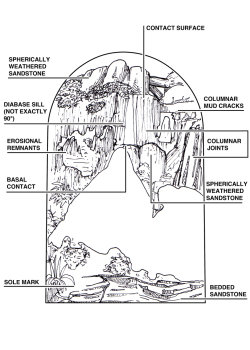Virgin of the Rocks, Louvre
From top to bottom: the rounded weathered mounds (spherical weathering) of horizontally layered (bedded) sandstone, a sedimentary rock, form the top of the grotto. The column of rock above the Virgin’s head is diabase, and igneous rock. When it was deposited on the sandstone, the diabase was a molten liquid. As it cooled, it formed a layer of rock called a sill. It also shrank in volume. The resulting contraction caused the rock to crack, perpendicular to the sandstone, forming columnar joints. The columnar joints are not perfectly vertical, but inclined slightly. This implies that the sandstone dips a few degrees away from the observer, which is borne out by close study of the layers.
Directly above the Virgin’s head is a horizontal line (basal contact) which separated the diabase sill from the sandstone below which has been spherically weathered. The texture and rounded weathering pattern are the same as those at the top of the grotto. In the foreground, the sandstone is layered, or bedded, with the utmost accuracy. In the background, rocky towers rise from a blue-gray mist, possibly surrounding a glacial lake in the Alps. These towers are remnants of erosional processes which stripped away the overlying softer rock and left the more weather resistant, harder rock intact.

